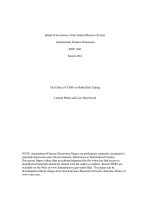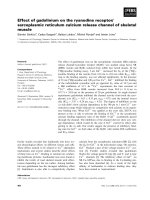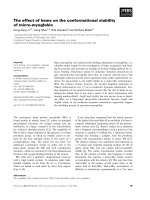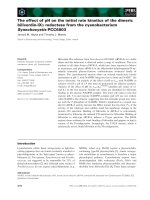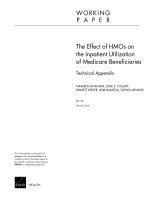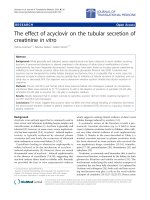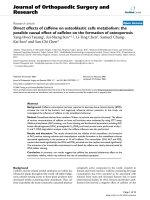Effect of radiation on the sensori neural auditory system and the clinical implications 2
Bạn đang xem bản rút gọn của tài liệu. Xem và tải ngay bản đầy đủ của tài liệu tại đây (1.32 MB, 190 trang )
1. INTRODUCTION
Radiation-induced radiation-induced sensori-neural hearing loss (SNHL) had long been
recognized as a complication of radiotherapy (RT) for head and neck tumours, if the
auditory pathways had been included in the radiation fields. It is believed that radiation
therapy was a much larger etiologic factor of hearing loss than suspected and should
clearly be recognized as a major factor in the etiology of adult hearing disorders
(Mencher et al, 1995). The incidence of SNHL after radiotherapy for nasopharyngeal
carcinoma (NPC) has been reported to be as high as 24% (Kwong et al, 1996).
NPC is common among the Chinese and the main modality of treatment for NPC is RT.
NPC is therefore common in Singapore, with a prevalence rate of 10.8 and 3.7 (age-
standardized) per 100,000 per year for males and females respectively (Seow et al, 2004).
In conventional RT of tumours located in the head and neck region, the auditory
pathways are often included in the radiation fields. In NPC, many patients with post-RT
hearing loss are encountered, both conductive and sensori-neural in nature (Low & Fong,
1998). While conductive hearing losses can normally be effectively overcome by wearing
appropriate hearing aids, the use of hearing aids in SNHL may possibly result in sounds
that are amplified but distorted (Low, 2005). Therefore, radiation-induced SNHL is of
particular concern in Singapore, where the post-treatment quality of life is increasingly
being emphasized.
1
Today, we are faced with a number of clinical issues related to the effects of radiation on
the sensori-neural audiory system. Do we know enough about these effects, so as to offer
feasible solutions to the important clinical problems? Specifically:
1. Can the high incidence of radiation-induced SNHL be reduced after RTof head and
neck tumours, if the auditory pathways had to be included in the radiation fields? This
may be possible if the cellular and molecular basis of radiation-induced ototoxicity is
known.
2. In patients with significant SNHL and whose auditory pathways had been irradiated
before, cochlear implantation may be clinically indicated to restore hearing. In
cochlear implantation, a pre-requisite for a successful outcome is intactness of the
retro-cochlear pathways. In conventional modern-day RT, even with effective
shielding of the brainstem, the cochlear nerve and ganglion are normally still at risk.
Therefore, will radiation damage the retro-cochlear pathways, such that cochlear
implants cannot work?
3. Combined chemo-radiotherapy using cisplatin (CDDP) has increasingly been used to
treat advanced head and neck cancers like NPC (Wee J et al, 2005; Plowman, 2002).
As CDDP is also known to be ototoxic, patients receiving combined radiation and
CDDP therapy may be at high risk of losing significant hearing. Therefore, will the
usefulness of combined therapy in head and neck cancers, be limited by unacceptable
synergistic ototoxic effects?
2
The relevant literature on the effects of radiation on the sensori-neural auditory system
and related topics will be reviewed, focusing on the issues that have important clinical
relevance. This thesis aims to address some of the gaps in knowledge that have the
potential to improve clinical outcomes in the immediate and near future.
3
2. LITERATURE REVIEW
2.1 Characteristics of radiation-induced SNHL
2.1.1. Animal studies
The effects of radiation on the inner ear was documented as early as 1905, when Ewald
placed radium beads in the middle ear of pigeons and noted labyrinthine symptoms.
Girden & Culler (1933) were first to evaluate the effects of radiation on hearing.
Experimenting on dogs subjected to various X ray doses, a hearing impairment averaging
5.5 dB was recorded. Novotny (1951) studied the ionizing effects of radiation in guinea
pigs and found a hearing impairment of about 8.4dB at 4000 Hz. Kozlov (1959) also
noted a hearing imparment of 3.9-9.1dB over 500-8000 Hz in guinea pigs. Gamble et al
(1968) subjected the ears of 50 guinea pigs to 500-6000 rads of radiation and found
decreased sensitivity of cochlear microphonics of 20-40dB, particularly in the high
frequencies. This was consistent with microscopic findings by Keleman (1963), who
demonstrated damage to Organ of Corti and cochlear duct in rats, after doses of 100-3000
rads. Tokimoto & Kanagawa (1985) in their study on guinea pigs concluded that even in
the absence of gross anatomical cochlear changes, post-irradiation functional hair cell
defects could exist
Histologically, Keleman (1963) studied temporal bones in rats which had received 100-
3000 rads of radiation. Haemorrhage was noted to be the most prominent finding with
4
destruction of the cochlear duct, organ of corti and its surrounding elements. Gamble et al
(1968) reported early changes of the stria vascularis, accompanied by significant
inflammatory responses in the inner ears of guinea pigs which had received 6000 rads of
radiation.
2.1.2 Human studies
Several clinical studies have recorded SNHL in patients who have had RT for head and
neck malignancies, where inner ear structures were included in the radiation fields. Leach
(1965) observed SNHL in some of the 56 patients who had received 3000-12000 rads of
RT for different head and neck cancers. Morretti (1976) retrospectively studied 137 post-
irradiated NPC patients, and found 7 to have SNHL of at least 10dB.
However, there had also been studies which suggested that radiation did not result in
significant SNHL (Evans et al, 1988). In a systematic review of the literature, Raajmakers
& Engelen (2002) explained that the conflicting results were attributed to variations in
patient groups, size, study design, follow-up period, radiotherapy techniques and
presentation of audiometric results. From the pooled data generated from their systematic
review, they concluded that about one-third of patients who had received 70 Gy in 2 Gy
per fraction near the inner ear, developed hearing loss of 10dB or more at 4 kHz.
Schnecht & Karmody (1966) reported the histological features of a deafened man who
had received 5,220 rads of radiation to the region of the ears several years ago.
5
Degeneration of the Organ of Corti was noted, with atrophy of the basilar membrane,
spiral ligament and stria vascularis. Progressive hearing loss across the various
frequencies had been attributed to obliterating endarteritis and eventual fibrosis, leading
to vascular compromise (Morreti, 1976).
2.1.3 Prevalence & epidemiology
Mencher et al (1995) lamented that it was difficult to establish the exact prevalence of
radiation-induced hearing loss because statistics relating to ototoxicity was often not well
kept or easily interpreted. Not only was hearing not often considered important in the
face of life-threatening diseases, hearing losses were frequently not recorded in those
who did not survive. Clinical studies had reported varying prevalence, depending on
factors such as dose, period of follow-up and definition/criteria used for hearing loss
(Raajmakers & Engelen, 2002). In NPC where the radiation dose received by the ear is
relatively high, the incidence of post-RT SNHL had been reported to be as high as 24%
(Kwong et al, 1996).
In SNHL after RT in NPC patients, sex and age were found to be independent prognostic
factors (Kwong et al, 1996). Males were noted to be more susceptible than females in
developing SNHL after radiation. Older patients were at greater risk, as pre-existing
degenerative changes could have made them more vulnerable to radiation injury (Wang
et al, 2003). Post-RT middle ear effusion was identified to be another predicting factor, as
toxic materials from chronic inflammation could affect the inner ear (Oh et al, 2004).
6
However, it is argued that the development of post-RT middle ear effusion could have
been just another manifestation of radiation damage related to individual variation in
susceptibility to radiation (Kwong et al, 1996).
2.1.4 Effect of radiation dose
Gamble et al (1968) found in guinea pigs that the extent of inner ear injury correlated
with the radiation dose applied. Bohne et al (1985) confirmed in chinchillas that the
higher the radiation dose received, the greater the damage to the inner ear. A systematic
review on human studies reported increasing loss with increasing dose, starting at about
40 Gy applied in 2 Gy per fraction (Raajmakers & Engelen, 2002). In fact, guidelines for
tolerance doses in normal tissues are being used in clinical practice (Emami et al, 1991).
It is noteworthy that early human studies had reported the effects of very high doses of
radiation to the ears, doses that are no longer used in clinical practice today (Thibadoux et
al, 1980; Talmi et al, 1988). Although these could have potentially provided rare
opportunities to study the effect of excessively high doses of radiation on the inner ear in
humans, documentation of the audiometric data was so poor that it was impossible to
draw conclusions on the relationship between high radiation dose and SNHL.
2.1.5 High frequency hearing loss
Hearing in the high frequencies were consistently found to be more affected than hearing
in the lower frequencies after irradiation (Raajmakers & Engelman, 2002; Talmi et al,
7
1989). This corresponded to histological observations made in animals that the basal part
of the cochlea (which respond to higher frequency sounds) was usually more damaged by
radiation than the apical part. Keleman (1963) demonstrated in rats that the apical turn of
the cochlea was least affected by radiation doses of 100-3000 rads. Winter (1970)
similarly reported in guinea pigs that post-irradiated apical hair cells remained intact
while the outer hair cells of the 2 basal turns were affected. Early threshold shifts at high
stimulus frequencies are indicators of probable subsequent shifts to low frequencies
(Schell et al, 1989).
2.1.6 Early vs late onset
Traditionally, radiation-induced SNHL is regarded to have either early or late onsets
(Talmi et al, 1989). The existence of early-onset radiation-induced cochlear damage had
been convincingly demonstrated in both animals and humans. Winter (1970) reported in
guinea pigs, hair cell damage as early as 6 hrs following radiation of 4,000-7,000 rads.
Tokimoto & Kanagawa (1985) demonstrated in guinea pigs that sensori-neural loss
appeared 3-10 hrs depending on dose administered, and outer hair cells in the basal turn
of the cochlea were destroyed about 6 hrs after radiation. In humans, SNHL often
occurred near the end or shortly after the completion of fractionated RT (Linskey &
Johnstone, 2003). Early-onset SNHL due to inflammatory causes or transient functional
disturbances in the stria vascularis, may recover with time (Kwong et al, 1996; Linskey &
Johnstone, 2003).
8
In late-onset hearing loss, Schuknecht & Karmordy (1966) observed marked atrophy of
the cochlear stria vascularis in a patient who had developed hearing loss 8 years after
radiotherapy (5200 rads) for carcinoma of the ear. Grau et al (1991) studied 22 NPC
patients with well-documented pre- and post-RT hearing levels over 7-84 months, and
found SNHL (especially the higher frequencies) developing 12 months post-RT.
Merchant et al (2004) were of the opinion that radiation-induced SNHL could only occur
4 years after irradiation. Delayed-onset hearing loss was found to correlate with age, pre-
existing SNHL and radiation dosage (Honore et al, 2002). Late-onset radiation-induced
SNHL had generally been attributed to progressive vascular compromise from radiation-
induced vasculitis obliterans (Morretti, 1976).
However, after a review of the relevant literature, Sataloff et al (1994) were not
convinced that late-onset hearing loss existed at all. They argued that although significant
hearing losses over the whole spectrum of the speech range were often seen several years
after radiation, there was little or no convincing evidence to support the notion that
hearing loss developing several years following radiation was causally related to
radiation therapy itself.
In summary, although early-onset radiation-induced SNHL and its progressive nature
have generally been well accepted, late-onset radiation-induced SNHL attributed to
progressive vascular compromise has not been convincingly shown. Therefore, late-onset
radiation-induced hearing loss may well be a later manifestation of progressive early-
onset hearing loss.
9
2.2 Effect of radiation on retro-cochlear pathways
2.2.1 The sensori-neural auditory pathways
According to Hackney (1987), the hair cells of the Organ of Corti transduce vibrations
within
the cochlea into neural signals. Outer hair cells are contractile
and may contribute
to mechanical feedback processes, whilst
the inner hair cells are apparently the primary
sensory cells
being innervated by the majority of the afferent fibres. These
run in the
cochlear nerve to the brain stem where they bifurcate,
projecting cochleotopically to the
dorsal and ventral cochlear
nuclei. A divergence continued in the main routes taken by
the
ascending pathways; one runs bilaterally from the ventral cochlear
nucleus to the
superior olivary complex and then to the inferior
colliculi, the other runs from the dorsal
cochlear nucleus to
the contralateral inferior colliculus. Fibres from the brainstem
nuclei
travelling to each inferior colliculus form a tract,
the lateral lemniscus, and may make
contact with one of the
nuclei within it. The pathway continues to the medial geniculate
bodies and on to the auditory cortex, preserving its cochleotopicity
at all levels. A
descending system parallels the ascending system
throughout. The presence of
commissural and decussating connections
from the level of the brainstem onwards,
provides the anatomical
basis for the analysis of binaural information. The division
of the
pathway forms the anatomical substrate for the parallel
processing of different features of
the auditory environment.
10
2.2.2 Mechanisms of damage to the nervous system
Awwad (1990) gave an account on radiation damage to the 3 main cell categories found
in the central nervous system namely neurons, vascular endothelial cells and glial cells.
Glial cells have a slow turn-over rate with a small precursor (stem-cell) compartment
(1%). Endothelial cells also have a slow turn-over rate but proliferate rapidly after injury.
Neurons are non-proliferating end-cells in the adult organism. Myelination of the nerve
axons is accomplished by the oligodendrocytes in the central nervous system and by
Schwann cells in the peripheral nerves. The following 4 types of damage can be
demonstrated in the rat spinal cord:
a) Transient demyelination is mediated by damage to the oligodendrocytes. In man,
transient myelopathy has a relatively short latent period of 3 months and is reversible
within 3 months. The main manifestations are paraesthesia and an electric shock-like
pain, which are common after irradiation to cervical spine
b) White matter necrosis has a latency period of about 3-6 months and requires doses
>20Gy. It is mediated by oligodendrocyte damage interacting with vascular injury. This
probably is responsible for early myelopathy found in humans
c) Vascular damage has a latency period of >7 months and requires relatively lower doses
(<20Gy). This type of injury probably causes progressive myelopathy in man
d) Spinal nerve root necrosis is caused by damage to the Schwann cells and results in
radiculopathy. For example, irradiation to the cauda equina results in flaccid paralysis
11
and muscle atrophy. However, there are no sensory manifestations indicating that in man,
the ventral roots are selectively damage
2.2.3 Cochlear vs retro-cochlear damage
Modern RT for head and neck tumours can potentially induce SNHL, as the cochlea and
parts of the auditory neural pathways are often included in the radiation fields. Kwong et
al (1996) reported sensori-neural hearing loss in NPC patients after RT, but did not
differentiate between sensory or neural deafness. Although radiation-induced SNHL is
generally believed to be a result of cochlear damage (Sataloff et al, 1994) it cannot be
assumed that retro-cochlear deafness does not occur, either alone or in combination with
cochlear deafness. The intactness of retro-cochlear auditory pathways is essential, if
cochlear implantation were to be considered for restoration and rehabilitation of hearing
loss in such patients.
2.2.4 Cerebral and bainstem damage
Temporal lobe necrosis after RT for NPC occurs. It can easily be missed as only one third
of these patients present with classical epilepsy and the latent period could range from 1.5
to 13 years (median five years) (Lee & Yau, 1997). Temporal lobe necrosis can result in
cognitive dysfunction, epilepsy and theoretically, central hearing dysfunction. However,
because of bilateral innervation to the auditory cortex, unilateral cortical damage does not
normally cause significant hearing problems.
12
Brainstem necrosis after RT for NPC is notorious because damage to the cochlear ganglia
and other neuronal cells can result in neural deafness and other even more serious
neurological complications (Lau et al, 1992; Grau et al, 1992). Grau et al (1991)
concluded that the deleterious effects of irradiation on hearing should be kept in mind in
both treatment planning and post-RT follow-up, based on their prospective study of 22
patients evaluated prior to and 7-84 months after radiotherapy for NPC. They found that
auditory brainstem evoked responses in 4 patients were severely abnormal and 2 had
clinical signs of brainstem dysfunction. Grau et al (1992) had shown by dose response
analysis, a correlation between total radiation doses received by the brainstem and the
incidence of pathologic brainstem evoked response audiometry (BERA). Patients who
had received RT doses of 59Gy or less to the brainstem had normal BERA, whereas 4 of
6 patients who had received a dose of 68 Gy manifested brainstem dysfunction.
Fortunately, the risk of this major complication has been minimized by the routine use of
effective shielding techniques in modern radiotherapy regimes (Leighton et al, 1997).
2.2.5 Spiral ganglia & cochlear nerve damage
Although the brainstem is well shielded during RT, the retro-cochlear auditory pathways
at the level of the spiral ganglia (located in the modiolus of the cochlea) and cochlear
nerve remain at risk, as these structures are not effectively shielded during treatment.
There have been only limited studies on the effects of radiation on the spiral ganglia and
auditory nerve, and the results have not been conclusive.
13
Namura et al (1997) demonstrated in rabbits, loss of ganglion cell bodies and cochlear
ganglia after more than 40 Gy of gamma radiation. On the other hand, Keleman (1963)
did not observe any effect on the cochlear nerve fibres after single doses of photon
radiation less than 20 Gy. As the effects of radiation on nervous tissues could be related
to dose, Bohne et al (1985) studied the effects of ionising radiation on the ear by
exposing chincillas to 40 to 90 Gy of radiation, fractionated at 2 Gy per day. The animals
were sacrificed two years after completion of treatment and the temporal bones were
studied microscopically. Dose dependent degeneration of sensory and supporting cells as
well as loss of 8
th
nerve fibres in the Organ of Corti, were observed. In ears exposed to
40-50Gy of radiation, the incidence of nerve fibre damage was 31%; whereas in ears
exposed to 60-90Gy, the incidence was 62%. The strength of this paper laid in the use of
fractionated doses (which resembled clinical practice) and the relatively long post-
treatment follow-up. However, because hearing tests were not performed in the study, it
could not be ascertained if hearing ability correlated with the degree of 8
th
nerve fibre
damage. It is pointed out that in an experiment on guinea pigs using auditory brainstem
responses to measure hearing thresholds before and after applying radiation ranging from
57.5 to 70Gy, no threshold changes were observed even up to 12 months post-RT
(Greene et al, 1992).
14
2.2.6 Necropsy studies
In a necropsy study on a patient who had hearing loss and previous radiotherapy for NPC,
preservation of Organ of Corti and degeneration of auditory nerve were observed (Gibb
& Loh, 2000). However, because tumour invasion and infection of the auditory nerve
were also present, it was not possible to substantiate the cause of auditory nerve
degeneration. Leach (1965) reported a patient with NPC who had received 40Gy of
radiation. He became progressively deaf and died 1 year later. The pathology report noted
spiral ganglion and nerve atrophy.
2.2.7 Clinical studies
Anteunis et al (1994) studied 18 patients who had received RT for parotid tumours at
daily doses of 2.0 to 2.5 Gy, to a total dose of 50 Gy. For malignancies, an additional
booster dose to a total of 60-70 Gy was given. At 2 years post RT, BERA showed
significant inter-aural latency difference for the I-V inter-peak time (indicating retro-
cochlear damage) in 3 patients (2 of whom were sub-clinical). However, it was not
ascertained that these findings were present prior to radiotherapy.
There had been 2 clinical studies on the effect of RT on retro-cochlear pathways in NPC
patients, but each had a follow-up period of only up to 1 year. Lau et al (1992)
prospectively studied 49 patients, and found a statistical difference between pre- and
15
post-RT I-III intervals which suggested retro-cochlear auditory damage. However, retro-
cochlear damage was not observed in a similar study conducted by Leighton et al (1997).
The conflicting result was attributed to the difference in techniques used during RT as in
the later, special efforts were made to confine radiation to anterior surface of the pons and
medulla. The ability of the retro-cochlear pathways to remain intact after irradiation is
supported by case reports. Coplan et al (1981) described a 12 year-old girl who had
received 5,000 rads of radiation for optic glioma. She developed SNHL 2 years after
radiotherapy and no audiologic signs of retro-cochlear damage were observed. Talmi et al
(1988) reported SNHL in a 35 year-old woman who had received a high total radiation
dose of 23,900 rads for facial hemangioma. Again, there was no evidence of retro-
cochlear damage with 90% speech discrimination, normal BERA and stapedial reflex.
2.2.8 Gamma radiosurgery for acoustic neuroma
Gamma knife stereotactic radiosurgery has become a popular modality of treatment for
acoustic neuroma (Chung et al, 2004). As hearing preservation is often an important
consideration in the management of acoustic neuroma (van Eck & Horstmann, 2005),
what is known about the effects of radiation on the cochlear nerve is of great clinical
relevance to such patients (Massager et al, 2006). Hirsch & Noren (1988) reported 64
patients with acoustic neuroma which were treated with stereotactic radiosurgery with
doses ranging from 1,800 to 5,000 rads. In these patients, 54% had pronounced
deterioration of thresholds and/or speech discrimination; BERA was abnormal in all but
one ear. However, because the post-irradiation hearing results are often confounded by
16
the tumour effect on the cochlear nerve (Kaplan et al, 2003), acoustic neuroma is not a
suitable clinical model to study the effects of radiation on the retro-cochlear auditory
pathways.
It can be seen that the existing literature gave conflicting views on the effect of
radiotherapy on the retro-cochlear pathways. It is pointed out that many of the studies
were retrospective and were based on small numbers of patients. Prospective studies on
the long-term effects beyond 1 year after irradiation, have not been done.
2.3 Combined effects of radiation and CDDP on SNHL
2.3.1 Combined chemo-radiotherapy for head & neck tumours
Combined chemo-radiotherapy is increasingly being used clinically to treat advanced
head and neck cancers. In RT of tumours in the head and neck region, the auditory
pathways are often included in the radiation fields and radiation-induced SNHL may
result. CDDP, widely used as an effective anti-neoplastic drug for these cancers, is also
well known to cause ototoxicity. Therefore, in combined therapy, the synergistic ototoxic
effects of CDDP and radiation could theoretically be catastrophic for the patient and is a
clinical issue that deserves more attention.
17
2.3.2 Properties of CDDP
CDDP is widely used in the treatment of epithelial malignancies such as lung, head and
neck, ovarian, bladder and testicular cancers. However, its clinical use is limited by its
severe adverse reactions which include not only ototoxicity but also renal toxicity from
renal tubular necrosis and interstitial nephritis, gastrointestinal toxicity and peripheral
neuropathy (Boulikas & Vouiouka, 2003)
There are various speculations why CDDP is ototoxic whereas most anti-neoplastics are
not (Ekborn, 2003). Firstly, it may be related to the small size of the molecule enabling it
to cross the blood-labyrinth barrier. Secondly, CDDP is not cell cycle specific and
therefore, can affect the non-dividing hair cells of the cochlea. Thirdly, mitochondria
which are common in the outer hair cells and the metabolically active stria vascularis, are
known to be important cellular targets for CDDP.
The mode of action of CDDP is still not completely understood but is thought to depend
on hydrolysis reactions where the –Cl group is replaced by a water molecule adding a
positive charge on the molecule (Boulikas & Vougiouka, 2003). The hydrolysis product
is believed to be the active species reacting mainly with glutathione in the cytoplasm and
the DNA in the nucleus, thus inhibiting replication, transcription and other nuclear
functions. A number of additional properties of CDDP are now emerging, including
activation of signal transduction pathways leading to apoptosis. Firing of such pathways
18
may originate at the level of the cell membrane after damage of receptor or lipid
molecules by CDDP, in the cytoplasm by modulation of proteins via interaction of their
thiol groups with CDDP and finally from DNA damage via activation of the DNA repair
pathways.
CDDP-induced hearing loss, first reported by Hill et al (1972), has a prevalence ranging
from as high as 91% to as low as 9 % (Sweetow & Will, 1993). Van der Hulst et al
(1988) explained that variability was a function of the terminology utilized to define
ototoxic change. In a review of 8 studies, most of which were in adults, the overall
incidence of hearing loss was 69%. (Skinner, 1990)
There is considerable inter-patient variability (Skinner, 1990). This could possibly be
contributed by variation in CDDP distribution to the inner ear or to genetic predisposition
(Miettinen et al, 1997). According to Mencher et al (1995), pre-existing hearing loss, age
and kidney function are confounding variables in the determination of CDDP ototoxicity.
They found that patients in poor general health were at greater risk for developing
CDDP-induced hearing loss. This included the plasma albumin level, in that lower
plasma albumin levels resulted in higher levels of active CDDP in the plasma. Red blood
cell count, haemoglobin and hematocrit levels also resulted in higher susceptibility
because of poorer oxygen transport capabilities. Intervention by blood transfusion,
general nutritional support, and administration of supplemental oxygen could therefore,
potentially reduce the risk of CDDP-induced hearing loss.
19
Morphological CDDP-induced changes in the Organ of Corti had been observed,
including damage to outer hair cells (especially in the basal turn of the cochlea), inner
hair cells, supporting cells, stria vascularis and spiral ganglion (Previati et al, 2004)
2.3.3 Combined ototoxicity of radiation & CDDP
Since radiation and cisplatin are both ototoxic, their combined use may possibly result in
greater SNHL than using RT alone. In fact, Skinner (1990) remarked that previous or
concurrent use of other ototoxic agents with CDDP, may increase toxicity by more than
simple algebric summation. Indeed, there have been a number of reports which described
enhanced radiatiation-induced ototoxicity when used with CDDP. In a study by Schnell
et al (1989) it was found that children and young adults treated with CDDP suffered an
additional 20-30dB SNHL if they had received prior cranial RT. In a study on children
and adolescents who had received CDDP for the treatment of solid tumours, Skinner et al
(1990) reported more severe CDDP ototoxicity in patients who had previously received
RT encompassing the ear. Similarly, Merchant et at (2004) observed enhanced
ototoxicity in a study on children with brain tumours who were treated by pre-RT
ototoxic chemotherapy. Miettinen et al (1997) also found that radiotherapy enhanced the
ototoxicity of CDDP in the higher speech frequencies. The results of these studies were
consistent with those from case reports, which supported the idea that RTshould be
considered cautiously in children treated with CDDP for intracranial malignancies
(Sweetow & Will, 1993; Walker et al, 1989)
20
On the other hand, there have also been reports which suggested that SNHL after
combined therapy was not significantly worse than after RT alone (Kwong et al 1996;
Wang et al, 2003; Oh et al, 2004; Kretschmar et al, 1990). In a prospective study on 32
patients with NPC who were treated by chemo-radiotherapy, Oh et al (2004) found the
incidence and features of SNHL after combined therapy for NPC to be similar to
historical data from RT alone. Two other studies on patients with NPC treated by chemo-
radiotherapy also showed that CDDP did not have an additional adverse effect on sensor-
neural hearing (Kwong et al, 1996; Wang et al, 2003). However, the dose of CDDP used
in both of these later studies were relatively low (<240 mg/ sq m)
As some of the studies which showed enhanced ototoxicity were done in patients where
chemotherapy was given after RT (rather than prior to RT), it had been suggested that the
order in which RT and chemotherapy was administered mattered. It was proposed that in
tissues that have been irradiated, post-irradiation hypereamia could cause increased
sensitivity of the cochlea to CDDP damage, although enhanced toxicity could occur even
up to 10 months after completion of radiation (Walker et al, 1989). Alternatively,
synergistic ototoxicity could also have resulted if radiation had provided a
“predisposition” to damage (Mencher et al, 1995) or had caused changes in permeability
of the inner ear and/or central nervous system barriers to CDDP (Miettinen et al, 1997).
This literature review has revealed that existing reports on the enhanced ototoxicity of
CDDP and radiation yielded gave conflicting results. In reality, most of these reports
were based on studies that were either retrospective or involved a limited number of
21
subjects. Data emanating from randomised trials were lacking. The true differences in
extent, onset and clinical course of SNHL between patients treated by combined chemo-
radiotherapy and RT alone, remain unknown.
2.4 Cellular & molecular basis of ototoxicity
2.4.1 Apoptotic cell death
According to Miller & Marx (1998), apoptosis is a highly regulated active form of
programmed cell death which allows a cell to self-degrade in order for the body to
eliminate unwanted or dysfunctional cells. Programmed cell death is a physiologically
normal event during development. Apoptosis is essential in embryonic development and
the maintenance of homeostasis in multicellular organisms. In humans, for example, the
rate of cell growth and cell death is balanced to maintain the weight of the body. During
fetal development, cell death helps to sculpt body shape, separating digits and making the
right neuronal connections. The correct cell density is achieved and maintained by a
tightly controlled process of generation and degeneration of cells. These cellular events
are regulated by genes, which are highly conserved from nematodes to humans. A toxic
insult to a cell can activate a cascade of cell death genes, thus leading to a cell’s demise.
Apoptosis is a gene-directed process whereby a cell activates a death program, effectively
committing to suicide. After a toxic insult, apoptosis protects the organism by deleting
22
any cells that have sustained enough damage to become potentially harmful to the
integrity of a tissue or organ. Apoptotic cells display a characteristic morphology that
primarily includes condensation of the nucleus and cytoplasm, nuclear fragmentation, and
cytoplasmic blebbing with an intact call membrane. Apoptosis is a controlled process
where the content of the cell is kept strictly within the cell membrane as it is degraded
(Raff, 1998). The apoptotic cell will be phagocytosed by macrophages before the cell’s
contents have a chance to leak. Therefore, apoptosis does not initiate an inflammatory
response.
Apoptosis can be triggered in a cell through either the extrinsic pathway or the intrinsic
pathways (Rybak, 2005). The extrinsic pathway is initiated through the stimulation of the
transmembrane death receptors, such as the Fas receptors, located on the cell membrane.
In contrast, the intrinsic pathway is initiated through the release of signal factors by
mitochondria within the cell (Figure 1).
The Extrinsic Pathway
In the extrinsic pathway, signal molecules known as ligands bind to transmembrane death
receptors on the target cell to induce apoptosis. For example, the immune system’s
natural killer cells possess the Fas ligand (FasL) on their surface (Cispo et al, 1998). The
binding of the FasL to Fas receptors (a death receptor) on the target cell will trigger
multiple receptors to aggregate together on the surface of the target cell. The aggregation
of these receptors recruits an adaptor protein known as Fas-associated death domain
23
protein (FADD) on the cytoplasmic side of the receptors. FADD, in turn, recruits
caspase-8, an initiator protein, to form the death-inducing signal complex (DISC).
Through the recruitment of caspase-8 to DISC, caspase-8 will be activated which will
directly activate caspase-3 (an effector protein) to initiate degradation of the cell. Active
caspase-8 can also cleave BID protein to tBID, which acts as a signal on the membrane of
mitochondria to facilitate the release of cytochrome c in the intrinsic pathway (Adrian,
2002).
The Intrinsic Pathway
The intrinsic pathway is triggered by cellular stress, specifically mitochondrial stress
caused by factors such as DNA damage and heat shock (Adrian, 2002). The Bcl-2 family
consists of a group of proteins that function as a checkpoint for cell death and survival
signals at the level of the mitochondria. Bcl-2 family members can be characterized as
either anti-apoptotic (eg Bcl-2) or pro-apoptotic (eg Bax). Upon receiving the stress
signal, the proapoptotic proteins in the cytoplasm, BAX and BID, bind to the outer
membrane of the mitochondria to signal the release of the internal content. Following the
release, cytochrome c forms a complex in the cytoplasm with the energy molecule
adenosine triphosphate (ATP) and the enzyme Apaf-1. Following its formation, the
complex will activate caspase-9, an initiator protein. The activated caspase-9 works
together with the complex of cytochrome c, ATP and Apaf-1 to form an apoptosome
which activates the effector protein caspase-3. Caspase 3 will in turn initiate the
downstream degradation process (Fig. 1).
24
For many years, apoptosis was thought to be a synonym for programmed cell death. In
recent years however, an increasing number of studies substantiated the existence of
caspase-independent forms of programmed cell death (Stefanis, 2005). Non-caspase
proteases such as cathepsins, calpains and granzymes may be involved, resulting in intra-
cellular signaling processes that lead to apoptotic or necrotic-like morphological forms of
programmed cell death (Leist & Jaattela, 2003). The initial model describing only one,
stereotypical form of active cell death is today viewed as an oversimplification. It is now
generally accepted that multiple forms of programmed cell death exist and that some
forms do not require activation of caspases. One single execution system such as the
caspase cascade, could easily be overcome by viruses and transformed cells. Hence,
alternative cell death pathways acting as backup pathways, might have evolved during
evolution.
25

